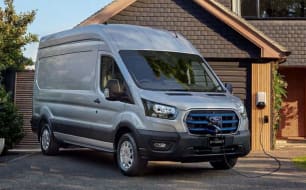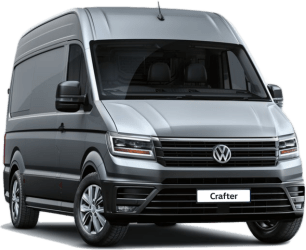Perhaps the most interesting thing about the design of the VW Crafter cab-chassis range is that there are so many options available.
You can have it as a single cab in three different lengths - Medium Wheelbase (MWB) spanning 5996mm total, Long Wheelbase (LWB) spanning 6846mm, and Long Wheelbase with Overhang (LWBO) stretching 7211mm.
Plus there are two double cab models available, the MWB and LWB, and both have seating for seven occupants - three up front, four in the rear.
And then there’s the fact you can have the Crafter in FWD, 4Motion all-wheel drive, or rear-wheel drive like our test vehicle. Both the FWD and AWD models have transverse mounted engines, while the RWD model has a north-south longitudinal engine.
The design of the vehicle varies based on that, with the FWD and AWD models offering better load-in height as they manage to package all the mechanical hardware down lower in the chassis. The RWD is more a heavy-duty option, and indeed is available in up to 5.5-tonne GVM configuration, meaning you need a truck licence to drive it. That’s not the case with our 4.49t GVM version, which is legal to be driven on a regular car licence.
It’s this availability of options that gives customers with very specific needs more choice to configure the vehicle they really want - and that is certainly an excellent design trait.
But one thing to consider is that all Crafter cab-chassis variants come with an Alloy Tray standard, and it’s fitted at the factory, rather than at the dealership.
The tray features a flat load-in space at the side, meaning you don’t need to contend with a rim or lip when forklifting items in, plus there are 10 recessed lashing eyes for tying down, and there’s an integrated rear step on the tailboard. The tray itself features a wooden floor (multi-layered birch plywood) which varies between vehicle types - you get the 15mm thickness for single rear tyre models, while dual-rear tyre versions get 21mm thickness.
The surface is designed to be non-slip via VW’s ‘screen-printed’ development, and on test we noted a little bit of slippage, so beware that items need to be well secured.
The tray’s sides are light and offer about 400mm of depth for storage, and there’s a side underride guard to stop other vehicles from pitching under the tray - and that also doubles as a handy step if the sides are up, but is not usable if the sides are dropped.
While the plastic latches are easy to operate I fear the forgetful apprentice may one day leave one unlocked, which could easily lead to it being smashed off in narrow confines. We also had some issues tying down to the front lashing eye with a ratchet strap because the ladder rack got in the way, and the recessed tie-downs collect leaf litter and worksite debris very easily.
And if you want the figures: the load area is 8.8 square metres, measuring 4300mm long, 2040mm wide and 400mm deep, with a load sill height of 1035mm.
The exterior cabin styling is Teutonic and fuss free, and it’s easy to determine this is a Crafter at a glance. One thing I wasn’t so taken by was the body-paint-coloured chassis rails, which had a number of rather messy looking welds that - if I was buying one for my business - I would prefer were black.
And if customising your vehicle to suit exactly your needs is important to you, here are some of the things you could add to your Crafter, if you want it: black steel wheels instead of silver; heated seats; a heated steering wheel with leather trim; a suspension seat for the driver and/or passenger (replacing the three-seat bench with a two-seat layout); a second battery setup; second alternator setup; sat nav media; tyre pressure monitoring; mechanical differential lock and hill descent control (4Motion models); active lane keeping assist; adaptive cruise control and more. More on the safety specs in the safety section below.
As you can probably tell from the interior images, there’s a bit to cover off for cabin practicality and design in the next section.













.png)


















